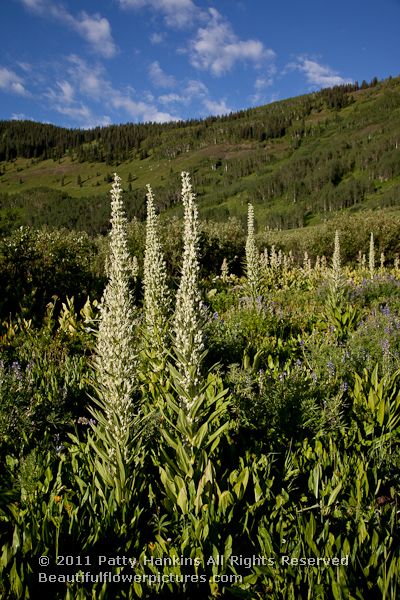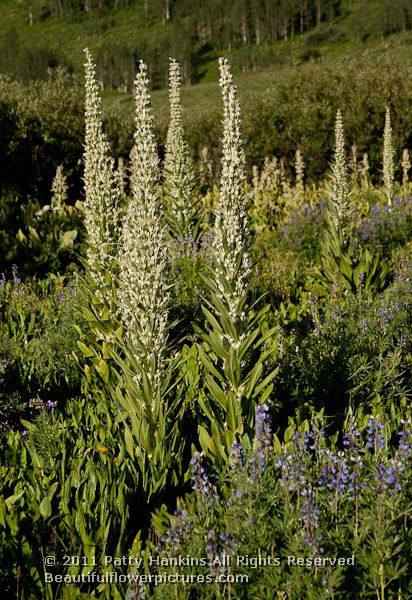by hankinslawrenceimages | Jan 20, 2011 | Colorado, Flowers, Gentianaceae Family, Photo Locations, Wildflowers
Last summer while I was photographing wildflowers in Colorado, I kept seeing groups of really tall plants. Finally on my last day of the trip, I was able to get close enough to some to get a good look at them, and photograph them. Now that I’ve figuredout what they are, I wish I’d spent more time with them.
 (c) 2011 Patty Hankins
(c) 2011 Patty Hankins
The plants are Frasera speciosa – commonly known as Monument plants, Elkweed or Green Gentian. A member of the Gentianaceae family, it can grow to 8 feet tall! The ones I photographed were probably close to that size. I certainly couldn’t see the tops of them without backing up and looking up. Long thought to be a biennial, research has shown that the Monument plants have a much more unusual life cycle. They are monocarpic plants having a lifespan of up to 80 years – and flowering only once during their lifetime. After they flower, the plants die. Another well known monocarpic plant is the century plant.
 (c) 2011 Patty Hankins
(c) 2011 Patty Hankins
Scientists suspect that environmental factors can cause a mass bloom like was seen in 2010 in Colorado. Research by Dr. David Inouye of the Rocky Mountain Biological Laboratory indicates that 4 years after a wet July & August, the monument plants form the flowering stalks.
 (c) 2011 Patty Hankins
(c) 2011 Patty Hankins
Monument plants are native to much of the western United States. They tend to grow in open mountain meadows, which is where I found them. They can grow to 8 feet tall with pale green lance shaped leaves of up to 18″. The flowers have either four or five sepals, are greenish white with purple glands and stiff hairs. The ones I photographed had four sepals and I didn’t see any of the purple glands. In some photos I’ve seen of the plants, the purple is very distinctive.
 (c) 2011 Patty Hankins
(c) 2011 Patty Hankins
Apparently I was very lucky to have seen this many monument plants blooming in Colorado last summer. I wish I’d been able to identify them earlier in the trip and had taken more photographs of them. Oh well, I can always hope to see more of them on future wildflower photography trips.
Some online sites with more information about Frasera Speciosa include
Southwest Colorado Wildflowers (I just found this site while researching the Monument Plants – it has lots of wonderful information!)
USDA Plant Profile
The Burke Museum of Natural History and Culture
Turner Photographics
Vascular Plants of the Gila Wilderness
Botany Photo of the Day
Lady Bird Johnson Wildflower Center
by hankinslawrenceimages | Jan 18, 2011 | Flowers, Rosaceae Family
As I’ve been going through my files, I keep finding sets of rose photos that I’ve never shared with you. With as gray as it has been here in the Washington DC area, I’m already wondering when spring will be arriving. If you’re feeling the same way, I hope these additional rose photos help remind you that winter will end and we will see spring and summer again. 🙂
The Madame A. Meilland Rose (also known as a Peace Rose) has a wonderful history. In the late 1930s, the French horticulturist Francis Meilland developed this amazing pink and yellow rose. Fearing the impact of the coming German invasion of France in 1939, Meilland sent cuttings of the rose to horticulturists is several countries. One cutting is said to have left France on the last plane to the United States before the war – the cutting went to the Conrad Pyle Company that propagated the roses.

Madame A Meilland Rose (c) 2010 Patty Hankins
During World War II, the rose became known by different names in different countries. In France – it is known as the Madame A. Meilland rose. In Italy – Gioia (Joy). In Germany – Gloria Dei (honor of God). In 1945, Meilland contacted Field Marshal Alan Brooke thanking him for his efforts to liberate Europe and asking if he could the rose after Brooke. Brooke declined and suggested that the rose be called “Peace”. Delegates to the inaugural meeting of the United Nations in 1945 were all given Peace Roses with a note that read “We hope the ‘Peace’ Rose will influence men’s thoughts for everlasting peace.”

(c) 2010 Patty Hankins
Honey Bouquet Rose is a floribunda rose known for it’s soft yellow color and large blossoms. It was introduced in 1999.
 (c) 2011 Patty Hankins
(c) 2011 Patty Hankins
Mrs. R.M Finch Rose is Polyantha shrub rose. Originally introduced in Australia in 1923, it has wonderful cupped semi-double rose-pink blossoms.

(c) 2009 Patty Hankins
And finally the Walking on Sunshine Rose. This is a very new rose – a 2011 AARS winner. It should be available this year. The flowers start in a bright shade of yellow gradually fading to a paler shade.

by hankinslawrenceimages | Jan 16, 2011 | Arizona, Photo Locations
One of the photographic themes from my trip along Route 66 in Arizona last month was dinosaurs. Many species of dinosaurs lived in what is now Arizona as far back as 245 million years ago. Their fossils are still being discovered in the state. There are some wonderful educational dinosaur exhibits and displays throughout the state.
And there are the dinosaurs I photographed along Route 66 . . .
The first set were at Stewart’s Petrified Wood Shop just outside of Holbrook. Their dinosaurs were unusual to say the least – constructed of paper-mache, strung with Christmas lights and most had a mannaquin attached to them in some way.

(c) 2011 Patty Hankins
 (c) 2011 Patty Hankins
(c) 2011 Patty Hankins
 (c) 2011 Patty Hankins
(c) 2011 Patty Hankins
We found more dinosaurs to photograph across the highway at the Painted Desert Indian Center. Since we were traveling Route 66 in December, it was nice to see the dinosaurs getting into the holiday spirit by wearing Christmas bows!
 (c) 2011 Patty Hankins
(c) 2011 Patty Hankins
 (c) 2011 Patty Hankins
(c) 2011 Patty Hankins
 (c) 2011 Patty Hankins
(c) 2011 Patty Hankins
And then finally I photographed one cute little dinosaur at the Wigwam Motel in Holbrook.
 (c) 2011 Patty Hankins
(c) 2011 Patty Hankins
I hope you’ve enjoyed my Route 66 dinosaurs. They definitely helped get everyone on the trip in right frame of mind for photographing some of the fun sights we saw.
by hankinslawrenceimages | Jan 14, 2011 | On the Web, Uncategorized

Harmony Dwarf Irises II (c) 2010 Patty Hankins
Here are some sites I found interesting recently. Hope you enjoy them.
Photography and Art Links
Photo Attorney has Q&A – Copyright Registration Issues
Dan Williams has What Makes “Fine Art” Photography
Guy Tal has Teach Yourself Photography in 80 Years
Serious Amateur Photography has Getting Tack Sharp Wildlife Shots
Light Stalking has The 7 Keys to Improving Your Photography This Year
Alain Briot has Preparation In Fine Art Landscape Photography – Part 1 of 2: Field and Studio Preparation
A Photo Editor has Thinking Of Working For Free?
John Paul Caponigro has The Art of Packing
The Art Newspaper has Art world up in arms at “light bulb” law
PDN Online has Shepard Fairey, AP Settle Copyright Lawsuit
Flowers, Plants & Gardening Links
BBC has Single peat moss plant ‘conquered America’
National Park and National Wildlife Refuge Links
National Park Service has Free Entrance Days in the National Parks – first one in 2011 is this weekend – January 15-17.
Refuge Watch has Salazar Announces Proposal for New Everglades Headwaters NWR and Interview with Refuge Filmmaker Emily Scott
National Parks Traveler hasPhoto Spot: Black Canyon of the Gunnison National Park and Grant Will Help Blue Ridge Parkway Ranger Collect Oral Histories
The Natural Capital has Nature Centers in the DC Area
Wildlife Links
Christian Science Monitor has What’s killing bumble bees? Some species’ numbers down 96 percent.
Climate Progress has Globe’s coral reefs suffer second worst bleaching on record during 2010
BBC has Drive to save the world’s most endangered coral species, Feeding garden birds such as tits delays dawn chorus, ‘Unethical’ flipper tags are damaging to penguins’
and Giant pandas ‘need old-growth forests’
National Parks Traveler has Annual Count Shows Huge Decline In Yellowstone National Park Elk Herd, But How Accurate Is It?
Environmental Issues Links
Christian Science Monitor has Gulf oil spill study’s surprisig find: Bacteria ate methane in three months and Gulf oil spill report warning: US must watch offshore drilling more closely
NY Times has Scope and Pace of Gulf Cleanup Is Criticized and Figures on Global Climate Show 2010 Tied 2005 as the Hottest Year on Record
National Parks Traveler has Report Lists 10 U.S. Ecosystems Whose Species Are Most-Threatened By Climate Change
Washington Post has Farmers group seeks to block EPA’s plan to clean Chesapeake Bay
by hankinslawrenceimages | Jan 12, 2011 | Flowers
Last week I posted photos of some of the wonderful pink lilies I’ve photographed recently. I thought today I’d post some of the white and yellow lily photos that I haven’t shared with you yet.
First is a Legend Lily – a pure white lily with a bright yellow stripe down the center

(c) 2010 Patty Hankins
A Nellie White Lily – frequently displayed at Easter. Known for it’s pure white trumpet shaped flowers
 (c) 2010 Patty Hankins
(c) 2010 Patty Hankins
A Siberia Lily – known for it’s many plumes of snowy white blossoms

(c) 2010 Patty Hankins
A Tarragona Lily – a lily with bright yellow center and creamy white edges
 (c) 2010 Patty Hankins
(c) 2010 Patty Hankins
And finally a Golden Stargazer lily – another lovely yellow & white lily
 (c) 2010 Patty Hankins
(c) 2010 Patty Hankins
I hope you’ve enjoyed seeing these lily photos. I love finding new varieties of lilies to photograph – so I’m sure I”ll be posting more lilies in the not too distant future.





















